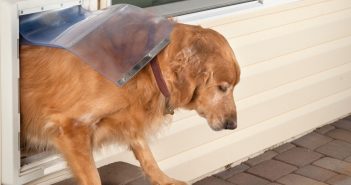Has going to the vet become an ordeal that you dread because of your dog’s anxieties and fears? Do they cry, shake, pace, drool or otherwise act like the veterinarian is going to torture them?
This problem is more common than you might realize. Whether you are trying to head off future problems, or improve the situation you are in now, the following four techniques are worth exploring.
1. Make a trip to the vet a positive experience for your dog.
Dogs, like people, prefer to do things that are enjoyable. Unlike humans, dogs cannot have the finer points of “This is for your own good!” explained to them. The solution is simply to make the veterinarian an enjoyable experience for your canine companion.
In the simplest of terms, you can do this by associating the vet with things your dog already loves. Bring a favorite tug toy and play with it outside the vet before going in. Have a ball obsessed dog? Nothing wrong with letting them show off to the vet how great they are with a quick retrieve!
Another great idea is to distract your dog with some impromptu clicker training at the vet’s office. Stick with behaviors your pooch is already very confident with. Make sure you are using a high rate of reward to keep their focus on you rather than their anxiety.
Be sure to be looking for any calm behavior and reward it with gentle pets and soft praise. If your pup lays down, make sure to take note. Likewise, praise good greetings (soft eyes and ears, level tail, no jumping) with any staff. Let them know it is okay to give your dog some positive attention and treats.
2. Combine a trip to the veterinarian with a fun activity.
Are you guilty of getting your dog in the car only for a trip to the vet? If your little guy knows that getting in the car always ends with the prick of a vaccine or the sounds of stressed animals, then they are probably ramping up their anxiety the whole way there.
On the other hand, if getting in the car sometimes lands a major reward like time with you on a favorite hiking trail or trip to the pet store, then they have more to look forward to when they hop in the car.
If you regularly do something fun after going to the vet, then you are teaching your pet to see that the vet is a precursor to fun. Over time this can take the sting out of an otherwise stressful time. It is especially beneficial if the fun includes some element of vigorous exercise to blow off any stress after the vet.
3. Help your dog learn to tolerate touch.
A common trigger that many canines have come to associate with going to the vet is being handled in ways that restrict their movement, followed by the prick of a shot.
If you happen to have a puppy, handle them often. Practice touching toes gently, tugging softly on their legs, holding them firmly to restrict movement, and other such excessive handling. Couple this touch therapy with good things like praise and rewards like a game of tug or a favorite chew bone.
If you have an adult dog you can do the same kinds of exercises to help them develop positive associations with being restrained and handled. It is important that when you do this kind of work with a dog that is already pretty nervous about being handled that you move slowly. Keep them under their reaction threshold and reward often.
4. Train your dog to wear a muzzle.
Although it might sound like it is moving in the wrong direction, muzzle training is something that could benefit all dogs. Consider it a precautionary measure…if you have already muzzle trained your dog, then you can pull it out of your back pocket in an emergency.
However, if you have a dog that you already know has severe anxiety at the veterinarian’s office, then a muzzle is a safety precaution that protects the staff, and ultimately, your dog. Even very good doggies can bite when they feel scared and cornered – there is just no reason to take chances.
Your vet has muzzles at the office. However, they are usually the mesh kind that tightly restrict your buddy’s mouth. They can make it difficult to breath, and can become one more reason your dog associates the vet with trauma.
If you correctly train your dog to wear a basket muzzle while in the safety of familiar environments with lots of positive reinforcement, then wearing it at the vet will be much less of a big deal.
The good news is that with some straightforward training and patience, you can usually improve your companion’s experience at the veterinarian, usually without the help of a professional animal behaviorist.




